PHYSICAL EDUCATION
Paper – II
Note : This paper contains fifty (50) objective type questions of two (2) marks each. All questions are compulsory.
1. A swimmer Joseph schooling winning the first ever Gold Medal for his country in Rio Olympics is from :
(1) Luxembourg
(2) Bolivia
(3) Singapore
(4) Iceland
2. Identify the athletes who have more ST fibres and relatively less FT fibres in their muscles
(1) Sprinters
(2) Shot-putters
(3) High jumpers
(4) Marathoners
3. Abduction of the arm about the gleno humeral joint is accompanied by :
(1) Abduction of the shoulder girdle
(2) Elevation of the shoulder girdle
(3) Upward tilt of the shoulder girdle
(4) Upward rotation of the shoulder girdle
4. Name the psychologist who defined stimulus in terms of physical energy such as mechanical pressure, sound etc.
(1) Thorndike
(2) Skinner
(3) Kohlar
(4) Hull
5. Philosophy of experimentalism that gave
(1) The basic theory of curriculum
(2) The realistic theory of curriculum
(3) The instructive theory of curriculum
(4) The make shift theory of curriculum
6. Which of these is not an inherited trait ?
(1) Shape of nose
(2) Tooth decay
(3) Blood group
(4) Skin colour
7. Which of the following factors should not be considered for talent identification ?
(1) Nature and duration of training in the past.
(2) Socio-economic conditions of child.
(3) Emotional state of child.
(4) Health status of the child.
8. If a chi-square test is to be performed on a contingency table with 3 rows and 4 columns, how many degrees of freedom should be used ?
(1) 12
(2) 10
(3) 8
(4) 6
9. The lateral deviation in spine are measured through
(1) Vertrebro graph
(2) Scolio meter
(3) Infra scolio
(4) Gonio spine
10. The last link of sports management chain is
(1) Control and evaluation
(2) Finance and budget
(3) Public relation
(4) Overall control
11. In Badminton, Dronacharya, Arjuna, Padma Shri, Padma Bhushan and Rajeev Gandhi Khel Ratna is awarded to :
(a) Prakash Padukone
(b) Mohammad Arif
(c) Pullela Gopichand
(d) Vimal Kumar
Code :
(1) (a), (b), (c)
(2) (a), (c)
(3) (c)
(4) (a), (c), (d)
12. Of the following therapeutic modatities, which are called penetrative thermo-therapy ?
(a) Wax bath
(b) Hydrotherapy
(c) Short wave diathermy
(d) Cryotherapy
(e) Electrotherapy
(f) Ultra-sound
Code :
(1) (a), (e)
(2) (c), (f)
(3) (c), (d)
(4) (b), (f)
13. Sesamoid bones are found in
(a) Mastoid process (b) Pisiform of the wrist
(c) First metacarpal bone (d) Hyoid bone
Codes :
(1) (a) and (b)
(2) (a) and (c)
(3) (b) and (c)
(4) (b) and (d)
14. Trait-centered orientation contends that motivated behaviour of sportsperson is primarily influenced by :
(a) Personality (b) Negative environment
(c) Need & goals (d) Competition
Codes :
(1) (a) and (c)
(2) (a) and (d)
(3) (b) and (c)
(4) (a) and (b)
15. Delphi technique for curriculum development has been employed :
(a) to set goals
(b) to determine organisational change
(c) to evaluate programme
(d) to assess students needs to develop curriculum ideas
(e) to ascertain community needs
Codes :
(1) (a), (b), (d), (e)
(2) (b), (c), (d), (a)
(3) (c), (d), (e), (b)
(4) (d), (e), (b), (a)
16. Which of the following food components have antioxidant effects ?
A. Phends B. Sesame Lignous
C. Vitamin – C D. Vitamin – D
E. Vitamin – E F. Corotenoid
Codes :
(1) A, C, E, F
(2) A, B, C, E, F
(3) B, D, E, F
(4) B, C, D, E
17. Find out the correct combination of the factors determining speed from the codes given below :
(a) Psychic factors
(b) Stretchability of muscles
(c) Flexibility
(d) Mobility of the nervous system
(e) Ligaments of the joint
Codes :
(1) (a), (b), (c)
(2) (b), (c), (d)
(3) (a), (c), (d)
(4) (c), (d), (e)
18. Which of the following strategies facilitate problem solving ?
(a) Algorithms
(b) Mental set
(c) Planning fallacy
(d) Heuristics
(e) Analogy
Codes :
(1) (a), (b) and (d)
(2) (b), (d) and (e)
(3) (a), (d) and (e)
(4) (b), (c) and (d)
19. The basic approaches used to develop criterion referenced standards for tests of human performance are
(a) Referenced equivalence approach
(b) Judge mental approach
(c) Minimal equivalence approach
(d) Normative approach
(e) Empirical approach
(f) Combination of all sources
(g) Rationale balance approach
Codes :
(1) (a), (b), (d), (g)
(2) (b), (c), (d), (e)
(3) (b), (d), (e), (f)
(4) (d), (e), (f), (g)
20. Intramural programme creates in students the sense of
(a) Selfishness
(b) Enmity
(c) Maximum involvement
(d) Mass participation
Codes :
(1) (a), (b)
(2) (d), (a)
(3) (d), (c)
(4) (c), (a)
21. Find the correct sequence of I, II, III and IV position winners of Rio De Janeiro Olympic Games 2016 in Badminton Women Singles Event :
(a) Carolina Marin
(b) Nozomi Okuhara
(c) Pursala Venkat Sindhu
(d) Li Xuerui
Codes :
(1) (a), (c), (b), (d)
(2) (a), (d), (c), (b)
(3) (a), (c), (d), (b)
(4) (d), (a), (c), (b)
22. Find the correct sequence of events that occur during transmission of nerve impulse :
a. Sodium influx
b. Change of membrane permeability
c. Action potential generated
d. Rupture of synaptic vesicle
e. Stimulation f. Depolarization
Code :
(1) e, f, b, a, d, c
(2) a, e, b, f, a, c
(3) b, a, f, c, d, e
(4) e, b, a, f, c, d
23. Arrange in sequence of constitute of synovial joint from inner to outer :
(a) Hyline cartilage (b) Synovial membrane
(c) Synovial fluid (d) Joint capsule
Codes :
(1) (a), (b), (c), (d)
(2) (a), (c), (b), (d)
(3) (a), (d), (c), (b)
(4) (b), (c), (d), (a)
24. Personal self-efficacy is based on four major sources of information. Arrange the information in sequential order from most influencing to least influencing.
(a) Past performance accomplishment
(b) Physiological arousal
(c) Precarious experiences
(d) Social & verbal persuasion
Codes :
(1) (a), (c), (d), (b)
(2) (a), (b), (c), (d)
(3) (b), (c), (d), (a)
(4) (c), (a), (b), (d)
25. Put the steps involved in observational learning in sequence of its occurrence :
(a) Reproduction
(b) Attention
(c) Motivation for later use
(d) Retention
Codes :
(1) (c), (d), (b), (a)
(2) (b), (d), (a), (c)
(3) (d), (b), (c), (a)
(4) (b), (a), (d), (c)
26. Sequentially arrange nutritive value in calories in per 100 gm of edible protein of common fruits in descending order :
(a) Mango (b) Guava
(c) Orange (d) Papaya
Codes :
(1) (a), (b), (c), (d)
(2) (d), (c), (a), (b)
(3) (a), (d), (b), (c)
(4) (b), (a), (c), (d)
27. In the formulation of a Macro-Cycle plan, mostly the following steps are followed.
Sequentially arrange them using the given codes :
(a) Determination of goal and sub-goals.
(b) Determination of periods and arrangement of meso-cycles.
(c) Performance proguosis and determination of performance structure.
(d) Determination of dates of tests, controls, competitions.
(e) Determination of load dynamics and load indices.
Codes :
(1) (c), (a), (d), (e), (b)
(2) (a), (c), (b), (d), (e)
(3) (c), (a), (b), (d), (e)
(4) (a), (b), (c), (d), (e)
28. Select the correct sequence of steps of research :
A. Formulation of Hypothesis
B. Collection of data
C. Formulation of generalisation and conclusion
D. Selection of Problem
E. Analysis of Data
F. Design of Research
G. Discussion on Hypothesis
Codes :
(1) D F A B E C G
(2) F B E A G D C
(3) D A F B E G C
(4) D F A B E G C
29. Arrange the items of Johnson Basket ball test in a sequential order :
a. Dribble
b. Basket ball throw for accuracy
c. Field goal speed test
Codes :
(1) c, b, a
(2) a, c, b
(3) c, a, b
(4) b, a, c
30. Arrange the universal principles of controlling in a sequence :
(a) Patting or pulling up people
(b) Develop comparable performance standard
(c) Evaluation of process and procedures
(d) Establish a reporting system
Codes :
(1) (d), (b), (c), (a)
(2) (b), (c), (a), (d)
(3) (c), (a), (d), (b)
(4) (a), (d), (b), (c)
31. Given below are two statements, one labelled as Assertion (A) and the other labelled as Reason (R) :
Assertion (A) : N.S.N.I.S. is the nodal agency in the country to look after sports promotions.
Reason (R) : The primary job of N.S.N.I.S. is to produce coaches of high caliber and significantly contribute in rendering their expertise and assistance in the preparation of national teams for international competitions.
In the context of the above statements, which one of the following is true ?
Codes :
(1) Both (A) and (R) are true and (R) is the correct explanation of (A).
(2) Both (A) and (R) are true, but (R) is not the correct explanation of (A).
(3) (A) is true, but (R) is false.
(4) (A) is false, but (R) is true.
32. Given below are two statements, one labelled as Assertion (A) and the other labelled as Reason (R) :
Assertion (A) : Drugs are chemical substances used for clinical purposes, unfortunately many athletes abusing drugs by taking banned items to enhance their performance unethically and illegal way.
Reason (R) : Knowing ill effects of smoking and alcohol many people consume them, then why athletes are debarred from taking drugs ? Only winners are glorified, therefore they may be allowed to enhance performance by any method.
In the context of the above statements, which one of the following is true ?
Codes :
(1) Both (A) and (R) are true and (R) is correct explanation of (A).
(2) Both (A) and (R) are true, but (R) is not the correct explanation of (A).
(3) (A) is true, but (R) is false.
(4) (A) is false, but (R) is true.
33. Given below are two statements, one labelled as Assertion (A) and the other labelled as Reason (R) :
Assertion (A) : A dimpled golf ball travel further than a smooth golf ball.
Reason (R) : The dimpled golf ball creates a small area of turbulent air behind it which create a small area of low pressure.
In the context of the above statements, which one of the following is true ?
Codes :
(1) Both (A) and (R) are true and (R) is the correct explanation of (A).
(2) Both (A) and (R) are true, but (R) is not the correct explanation of (A).
(3) (A) is true, but (R) is false.
(4) (A) is false, but (R) is true.
34. Given below are two statements, one labelled as Assertion (A) and the other labelled as Reason (R) :
Assertion (A) : Theory of competence motivation contends that perception of control to learn & perform skills work along with self-worth & competence to influence motivation.
Reason (R) : These feelings do not affect motivation directly but influence emotional state such as enjoyment, anxiety, pride, shame etc., and in turn motivate sports person.
In the context of the above statements, which one of the following is true ?
Codes :
(1) Both (A) and (R) are true and (R) is correct explanation of (A).
(2) Both (A) and (R) are true, but (R) is not the correct explanation of (A).
(3) (A) is true, but (R) is false.
(4) (A) is false, but (R) is true.
35. Given below are two statements, one labelled as Assertion (A) and the other labelled as Reason (R) :
Assertion (A) : The curriculum includes all the learner’s experiences in or outside the school that are included in a programme which has been devised to help him develop mentally, physically, emotionally, socially spiritually and morally.
Reason (R) : The term curriculum is of Latin origin and it implies an athletic ground, thus indicating that curriculum is the ground through which the educand has to pass in order to reach a definite goal.
In the context of the above statements, which one of the following is true ?
Codes :
(1) Both (A) and (R) are true and (R) is the correct explanation of (A).
(2) Both (A) and (R) are true, but (R) is not the correct explanation of (A).
(3) (A) is true, but (R) is false.
(4) (A) is false, but (R) is true.
36. Given below are two statements, one labelled as Assertion (A) and the other labelled as Reason (R) :
Assertion (A) : Dietary fibre is thought to be associated with enhanced incidence of coronary heart diseases.
Reason (R) : The mechanism of its action is attributed to its binding to bile salt and preventing its re absorption, and thus affecting cholesterol level in circulation.
In the context of the above statements, which one of the following is true ?
Codes :
(1) Both (A) and (R) are true and (R) is correct explanation of (A).
(2) Both (A) and (R) are true, but (R) is not the correct explanation of (A).
(3) (A) is true, but (R) is false.
(4) (A) is false, but (R) is true.
37. Given below are two statements, one labelled as Assertion (A) and the other labelled as Reason (R) :
Assertion (A) : The aim of direct preparation for competition is to achieve year’s best performance in the main competition.
Reason (R) : Direct preparation is also important for build-up competition to perform well in practice match.
In the context of the above statements, which one of the following is true ?
Codes :
(1) Both (A) and (R) are true and (R) is correct explanation of (A).
(2) Both (A) and (R) are true, but (R) is not the correct explanation of (A).
(3) (A) is true, but (R) is false.
(4) (A) is false, but (R) is true.
38. Given below are two statements, one labelled as Assertion (A) and the other labelled as Reason (R) :
Assertion (A) : A dependent variable is the factor manipulated by the experimenter in his attempt to ascertain its relationship to an observed phenomenon.
Reason (R) : An independent variable is the presumed cause of the dependent variable and the dependent variable is the presumed effect of independent variable.
In the context of the above statements, which one of the following is true ?
Codes :
(1) Both (A) and (R) are true and (R) is correct explanation of (A).
(2) Both (A) and (R) are true, but (R) is not the correct explanation of (A).
(3) (A) is true, but (R) is false.
(4) (A) is false, but (R) is true.
39. Given below are two statements, one labelled as Assertion (A) and the other labelled as Reason (R) :
Assertion (A) : Validity is affected by the consistency in the results of a test.
Reason (R) : Inconsistency in test results will lower the correlation with a validating criterion.
In the context of the above statements, which one of the following is true ?
Codes :
(1) Both (A) and (R) are true and (R) is correct explanation of (A).
(2) Both (A) and (R) are true, but (R) is not the correct explanation of (A).
(3) (A) is true, but (R) is false.
(4) (A) is false, but (R) is true.
40. Given below are two statements, one labelled as Assertion (A) and the other labelled as Reason (R) :
Assertion (A) : Authoritarian or autocratic management is primarily a “one-man” show where the executive at the top wields all powers the supreme authority to say.
Reason (R) : Every word uttered by him is a command that must be obeyed every one, An autocratic administrator tolerates neither dissent nor disagreement.
In the context of the above statements, which one of the following is true ?
Codes :
(1) Both (A) and (R) are true and (R) is correct explanation of (A).
(2) Both (A) and (R) are true, but (R) is not the correct explanation of (A).
(3) (A) is true, but (R) is false.
(4) (A) is false, but (R) is true.
41. Match List – I with List – II and select the correct option from the codes given below :

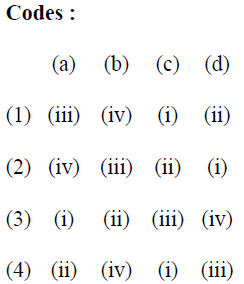
42. Match List – I with List – II and select the correct option from the codes given below :


43. Match List – I with List – II and select the correct option from the codes given below :


44. Match List – I with List – II and select the correct option from the codes given below :

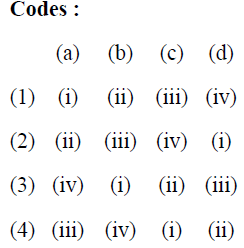
45. Match List – I with List – II and select the correct option from the codes given below :
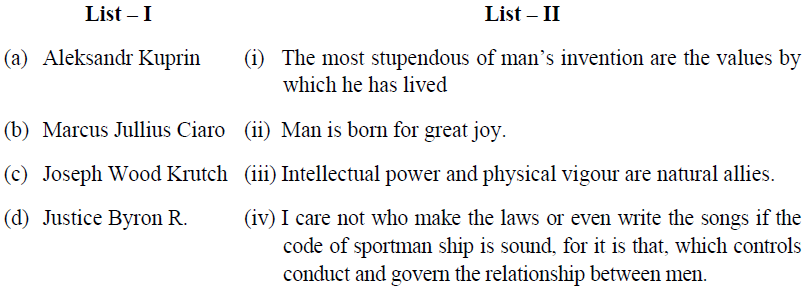
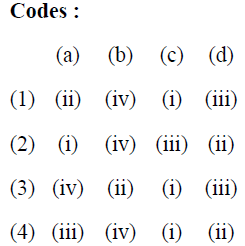
46. Match List – I with List – II and select the correct option from the codes given below :

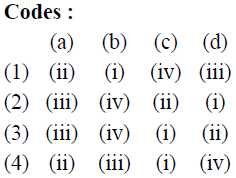
47. Match List – I with List – II and select the correct option from the codes given below :

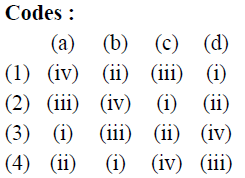
48. Match List – I with List – II and select the correct option from the codes given below :
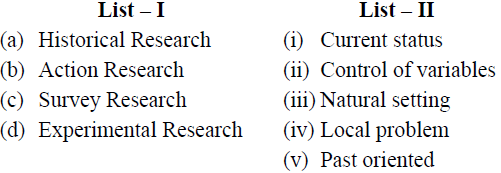

49. Match List – I with List – II and select the correct option from the codes given below :
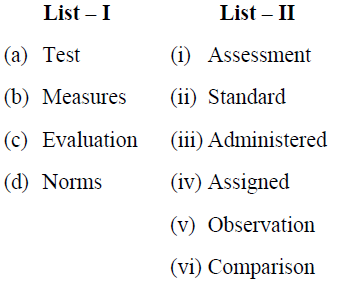
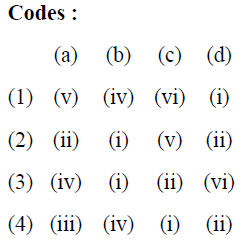
50. Match List – I with List – II and select the correct option from the codes given below :

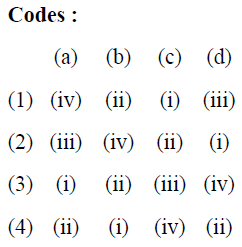
Latest Govt Job & Exam Updates: